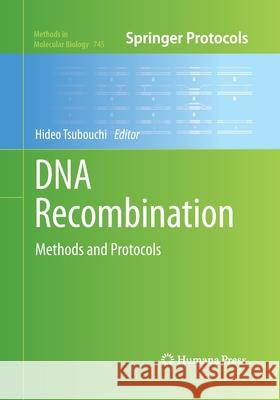DNA Recombination: Methods and Protocols » książka



DNA Recombination: Methods and Protocols
ISBN-13: 9781493957781 / Angielski / Miękka / 2016 / 565 str.
DNA Recombination: Methods and Protocols
ISBN-13: 9781493957781 / Angielski / Miękka / 2016 / 565 str.
(netto: 494,87 VAT: 5%)
Najniższa cena z 30 dni: 487,26 zł
ok. 16-18 dni roboczych.
Darmowa dostawa!
Divided into four convenient sections, DNA Recombination: Methods and Protocols covers recent techniques that best utilize the advantages of the yeast system. With its well-honed methodologies, the book is as an ideal guide to scientists of all backgrounds.
Part I. Genetic and Molecular Biological Approaches with Yeast
1. Methods to Study Mitotic Homologous Recombination and Genome Stability
Xiuzhong Zheng, Anastasiya Epstein, and Hannah L. Klein
2. Characterizing Resection at Random and Unique Chromosome Double-Strand Breaks and Telomere Ends
Wenjian Ma, Jim Westmoreland, Wataru Nakai, Anna Malkova, and Michael A. Resnick
3. Characterization of Meiotic Recombination Initiation Sites Using Pulsed-field Gel Electrophoresis
Sarah Farmer, Wing-Kit Leung, and Hideo Tsubouchi
4. Genome-Wide Detection of Meiotic DNA Double-Strand Break Hotspots Using Single-stranded DNA
Hannah G. Blitzblau and Andreas Hochwagen
5. Detection of Covalent DNA-Bound Spo11 and Topoisomerase Complexes
Edgar Hartsuiker
6. Molecular Assays to Investigate Chromatin Changes during DNA Double-Strand Break Repair in Yeast
Scott Houghtaling, Toyoko Tsukuda, and Mary Ann Osley
7. Analysis of Meiotic Recombination Intermediates by Two-Dimensional Gel Electrophoresis
Jasvinder A. Singh and G. Valentin Börner
8. Mapping of Crossover Sites Using DNA Microarrays
Stacy Y. Chen and Jennifer C. Fung
9. Using the Semi-Synthetic Epitope System to Identify Direct Substrates of the Meiosis-Specific Budding Yeast Kinase, Mek1
Hsiao-Chi Lo and Nancy M. Hollingsworth
10. Genetic and Molecular Analysis of Mitotic Recombination in Saccharomyces cerevisiae
Belén Gómez-González, José F. Ruiz, and Andrés Aguilera
11. In vivo Site-Specific Mutagenesis and Gene Collage Using the Delitto Perfetto System in Yeast Saccharomyces cerevisiae
Samantha Stuckey, Kuntal Mukherjee, and Francesca Storici
12. Detection of RNA-Templated Double-Strand Break Repair in Yeast
Ying Shen and Francesca Storici
Part II. Genetic and Molecular Biological Approaches with Higher Eukaryotes
13. SNP-Based Mapping of Crossover Recombination in C. elegans
Grace C. Bazan and Kenneth J. Hillers
14. Characterization of Meiotic Crossovers in Pollen from Arabidopsis thaliana
Jan Drouaud and Christine Mézard
15. Isolation of Meiotic Recombinants from Mouse Sperm
Francesca Cole and Maria Jasin
16. Homologous Recombination Assay for Interstrand Crosslink Repair
Koji Nakanishi, Francesca Cavallo, Erika Brunet, and Maria Jasin
17. Evaluation of Homologous Recombinational Repair in Chicken B Lymphoma Cell Line, DT40
Hiroyuki Kitao, Seiki Hirano, and Minoru Takata
18. Understanding the Immunoglobulin Locus Specificity of Hypermutation
Vera Batrak, Artem Blagodatski, and Jean-Marie Buerstedde
Part III. In Vitro Reconstitution of Homologous Recombination Reactions and Single Molecular Analysis of Recombination Proteins
19. Quality Control of Purified Proteins Involved in Homologous Recombination
Xiao-Ping Zhang and Wolf-Dietrich Heyer
20. Assays for Structure-Selective DNA Endonucleases
William D. Wright, Kirk T. Ehmsen, and Wolf-Dietrich Heyer
21. In vitro Assays for DNA Pairing and Recombination-Associated DNA Synthesis
Jie Liu, Jessica Sneeden, and Wolf-Dietrich Heyer
22. An In vitro Assay for Monitoring the Formation and Branch Migration of Holliday Junctions Mediated by a Eukaryotic Recombinase
Yasuto Murayama and Hiroshi Iwasaki
23. Reconstituting the Key Steps of the DNA Double-Strand Break Repair In vitro
Matthew J. Rossi, Dmitry V. Bugreev, Olga M. Mazina, and Alexander V. Mazin
24. Biochemical Studies on Human Rad51-Mediated Homologous Recombination
Youngho Kwon, Weixing Zhao, and Patrick Sung
25. Studying DNA Replication Fork Stability in Xenopus Egg Extract
Yoshitami Hashimoto and Vincenzo Costanzo
26. Supported Lipid-Bilayers and DNA Curtains for High-Throughput Single Molecule Studies
Ilya J. Finkelstein and Eric C. Greene
27. FRET-Based Assays to Monitor DNA Binding and Annealing by Rad52 Recombination Mediator Protein
Jill M. Grimme and Maria Spies
28. Visualization of Human Dmc1 Presynaptic Filaments
Michael G. Sehorn and Hilarie A. Sehorn
Part IV. Cell Biological Approaches to Study the In Vivo Behavior of Homologous Recombination
29. Tracking of Single and Multiple Genomic Loci in Living Yeast Cells
Imen Lassadi and Kerstin Bystricky
30. Cell Biology of Homologous Recombination in Yeast
Nadine Eckert-Boulet, Rodney Rothstein, and Michael Lisby
31. Live Cell Imaging of Meiotic Chromosome Dynamics in Yeast
Harry Scherthan and Caroline Adelfalk
32. Chromosome Structure and Homologous Chromosome Association during Meiotic Prophase in C. elegans
Kentaro Nabeshima
Homologous recombination is important in various aspects of DNA metabolism, including damage repair, replication, telomere maintenance, and meiosis, and yeast genetics has successfully provided a framework for the mechanism of homologous recombination. Divided into four convenient sections, DNA Recombination: Methods and Protocols covers recent techniques that best utilize the advantages of the yeast system, prescribing to the belief that yeast will keep serving as a great model organism to study homologous recombination. Chapters have also been included for such exceptions as the group of genes involved in recombination that are found solely in higher eukaryotes, such as BRCA2. And looking forward, a necessary step in the direction of understanding the homologous recombination process is to isolate the machine and let it work in a test tube. Understanding the design by studying the appearance and behavior of the machinery as a single molecule will be an important milestone toward understanding the mechanism of action of the machinery. Techniques covering these topics have also been included. Written in the successful Methods in Molecular Biology™ series format, chapters include introductions to their respective topics, lists of the necessary materials and reagents, step-by-step, readily reproducible protocols, and notes on troubleshooting and avoiding known pitfalls.
Authoritative and easily accessible, DNA Recombination: Methods and Protocols serves as an ideal guide to scientists of all backgrounds with its well-honed methodologies and strives to bring the reader to the next level of understanding regarding this vital subject.
1997-2025 DolnySlask.com Agencja Internetowa
KrainaKsiazek.PL - Księgarnia Internetowa









